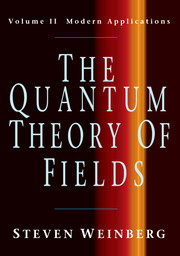Book contents
- Frontmatter
- Contents
- PREFACE TO VOLUME II
- NOTATION
- 15 NON-ABELIAN GAUGE THEORIES
- 16 EXTERNAL FIELD METHODS
- 17 RENORMALIZATION OF GAUGE THEORIES
- 18 RENORMALIZATION GROUP METHODS
- 19 SPONTANEOUSLY BROKEN GLOBAL SYMMETRIES
- 20 OPERATOR PRODUCT EXPANSIONS
- 21 SPONTANEOUSLY BROKEN GAUGE SYMMETRIES
- 22 ANOMALIES
- 23 EXTENDED FIELD CONFIGURATIONS
- AUTHOR INDEX
- SUBJECT INDEX
22 - ANOMALIES
Published online by Cambridge University Press: 05 May 2013
- Frontmatter
- Contents
- PREFACE TO VOLUME II
- NOTATION
- 15 NON-ABELIAN GAUGE THEORIES
- 16 EXTERNAL FIELD METHODS
- 17 RENORMALIZATION OF GAUGE THEORIES
- 18 RENORMALIZATION GROUP METHODS
- 19 SPONTANEOUSLY BROKEN GLOBAL SYMMETRIES
- 20 OPERATOR PRODUCT EXPANSIONS
- 21 SPONTANEOUSLY BROKEN GAUGE SYMMETRIES
- 22 ANOMALIES
- 23 EXTENDED FIELD CONFIGURATIONS
- AUTHOR INDEX
- SUBJECT INDEX
Summary
There are subtleties in the implications of symmetries in quantum field theory that have no counterpart in classical theories. Even in renormalizable theories, the infinities in quantum field theory require that some sort of regulator or cut-off be used in actual calculations. The regulator may violate symmetries of the theory, and even when this regulator is removed at the end of the calculation it may leave traces of this symmetry violation. This problem first emerged in trying to understand the decay rate of the neutral pion, in the form of an anomaly that violates a global symmetry of the strong interactions. Anomalies can also violate gauge symmetries, but in this case the theory becomes inconsistent, so that the condition of anomaly cancellation may be used as a constraint on physical gauge theories. The importance of anomalies will become even more apparent in the next chapter, where we shall study the non-perturbative effects of anomalies in the presence of topologically non-trivial field configurations.
The π° Decay Problem
By the mid-1960s the picture of the pion as a Goldstone boson associated with a spontaneously broken SU(2)⊗ SU(2) symmetry of the strong interactions had scored a number of successes, outlined here in Chapter 19. However, this picture also had a few outstanding failures. The most disturbing had to do with the rate of the dominant decay mode of the neutral pion, π0→ 2γ.
- Type
- Chapter
- Information
- The Quantum Theory of Fields , pp. 359 - 420Publisher: Cambridge University PressPrint publication year: 1996
- 1
- Cited by



